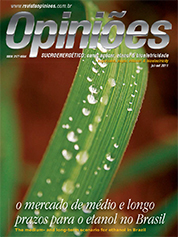Mauricio Tiomno Tolmasquim
President of Empresa de Pesquisa Energética – EPE
Op-AA-29
Promising future for Brazil’s ethanol
The Brazilian energy matrix stands out in the global context due to its renewability. Our country, blessed with clean natural energy sources at competitive market costs, nowadays has 45% of its matrix based on renewable supplies, as opposed to an average of 13% in OECD member countries, and only 8% globally.
The increase in the share of sugarcane products, which in 2008 surpassed hydroelectric energy, should be emphasized, since they became our country’s second most important source. In 2010, sugarcane-derived products represented about 18% of the energy matrix, the result of the increase in the use of ethanol in the transportation industry.
The outlook of the Brazilian economy is favorable in terms of investment, credit and labor market, resulting in strong expansion of domestic activity. One of its effects is the increase in motorization, which will go from 6.5 habitants per vehicle in 2010 to 3.9 in 2020.
The increase in the automobile fleet, expected to reach 50 million vehicles by 2020, will be accompanied by growth of the flex-fuel vehicle fleet. Currently, flex-fuel cars represent about 90% of light vehicle sales in the country. At this rate, the share of such automobiles in the national fleet will reach 80% in ten years.
In its studies, Empresa de Pesquisa Energética - EPE, estimates that the share of this fuel in the flex-fuel category will be 70% in 2020. In this scenario, domestic demand for hydrated ethanol will reach the 56 billion liters mark in 2020. An extraordinary expansion, leveraged by the increase of the flex-fuel fleet. Furthermore, projections show that Brazil will uphold the leading position internationally in the medium-term, exporting at least 7 billion liters in 2020.
On the other hand, the reduction in the use of gasoline will cause a slight reduction in demand for anhydrous ethanol, estimated at 7 billion liters in 2020. In parallel, the ethanol production destined for other uses will be negligible, of about 3.5 billion liters.
The net effect of transformation in the industry is important growth in total ethanol demand, expected to reach almost three times in the next 10 years, from currently 27 to 73 billion liters in 2020.
To face this growth in demand, one estimates investments in the magnitude of R$ 100 billion in the next ten years to increase the supply of ethanol – production mills and pipeline and port infrastructure.
All this expansion will imply substantial increase in the national co-generation capacity based on the use of sugarcane bagasse. Since 2004, the Federal Government contracted about 1,300 average MW through its Proinfa (the Alternative Energy Source Incentive Program) and energy sale auctions.
There is still a lot to be accomplished, because the industry’s technical potential is much more expressive. Investing in higher installation efficiency, one can export surplus electric energy to the Interconnected National System, while meeting industrial units’ own consumption needs.
With the strong growth in ethanol production, the availability of bagasse will also increase and hence, the sales potential of surplus electric energy generated by the mills. According to data of BEN (the Brazilian National Energy Balance), approximately 44% of the 135.4 million tons of bagasse consumed as energy in 2009 were destined to the production of ethanol.
The trend is that, for the duration of the 2020 PDE (the Decennial Energy Expansion Plan), this fuel will start to represent the biggest absorption share of sugarcane bagasse in the energy industry, whether due to the increase in the supply of raw material or to better dynamics in liquid fuel markets in comparison with sugar.
Projections for the demand of sugarcane bagasse, which will grow at 5.7% per year between 2010 and 2020 in the country, are at 238 million tons consumed at the end of the decade. Thus, the ethanol industry would be able to generate up to 10,000 average MW in 2020 with the available bagasse.
It is important to mention that investments in technology may expand the production potential of sugarcane and diversify derivative products such as renewable diesel and cellulosic ethanol obtained from bagasse and straw.
Thus, the country will stay ahead in terms of renewability in the medium-term. EPE’s estimates show that in 2020, 46% of the Brazilian energy matrix will originate from clean natural and renewable sources, of which practically half – approximately 22% - will come from sugarcane derivatives.




